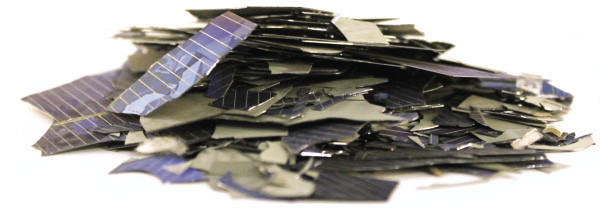 By now, almost everyone has seen the much touted 2016 figures released by the International Energy Agency (IEA) and the International Renewable Energy Agency (IRENA). An estimated 1.7 million to 8 million tons of cumulative PV waste is expected by the 2030s, and 60 million to 78 million tons by the 2050s. It will primarily come from China, the United States, Japan, India, and Germany.
By now, almost everyone has seen the much touted 2016 figures released by the International Energy Agency (IEA) and the International Renewable Energy Agency (IRENA). An estimated 1.7 million to 8 million tons of cumulative PV waste is expected by the 2030s, and 60 million to 78 million tons by the 2050s. It will primarily come from China, the United States, Japan, India, and Germany.
A report released by the IEA’s Photovoltaic Power Systems Program in January 2018 – “End-of‐Life Management of Photovoltaic Panels: Trends in PV Module Recycling Technologies” – shows that a total of 178 PV recycling patents have been filed, marking a “drastic increase” since 2011. Of these, 128 are focused on crystalline silicon (c-Si) technology, while the remaining 44 are for compound technologies, which include thin-film modules. Almost half of all the patents originated in China, although increased activity has also been seen in South Korea and Japan.
Currently, the EU is the only region worldwide to have adopted a clear regulatory framework specifically supporting PV module recycling. The WEEE (waste electrical and electronic equipment) Directive for solar was rolled out in 2012 and obliges producers to take back PV modules for free and recycle them. This was the first law passed that dealt with the topic of PV waste. Under it, 75% to 65% (recovery/recycling rate) of waste PV modules by mass were to be recycled through 2016, increasing to 80% to 75% through 2018. These figures now stand at 85% to 80%.
Lagging behind
While there are currently no specific laws in other countries dealing with end-of-life (EOL) PV modules, regulatory activity is ramping up in places like Japan, India, Australia, and the United States.
In 2018, Marina Monteiro Lunardi, Juan Pablo Alvarez-Gaitan, José I. Bilbao and Richard Corkish – the authors of “A Review of Recycling Processes for Photovoltaic Modules” – reported that the Japan Photovoltaic Energy Association (JPEA) published voluntary guidelines in 2017 on how to properly dispose of EOL modules. “Also, manufacturers, importers and distributors of photovoltaic modules have been invited to provide information on the chemical substances contained in the product and to inform the waste disposal companies. JPEA strongly recommend that industry follow the guidelines.”
In Australia, a national program led by the state of Victoria, in collaboration with the PV industry, aims to make recommendations on a preferred national management approach to PV waste management.
Attempts to move beyond the U.S. Resource Conservation and Recovery Act, which regulates hazardous and non-hazardous waste management, have also been made in the United States. For example, California is looking to introduce the concept of extended producer responsibility, while Washington state was the first U.S. jurisdiction to require PV recycling.
Smuggling solar
According to a policy document released by RPVS in July, it estimates that “less than 10% of decommissioned panels [in the United States] are recycled with the remaining 90% going to landfills or sold/‘donated’ to developing countries with weak environmental protection and product safety enforcement.”
Supporting this, pv magazine reported in February that Italy’s Carabinieri Command for the Protection of the Environment seized a €4 million waste treatment plant near Catania, Sicily, on suspicion that panels sent there for recycling were smuggled on to African and Middle Eastern markets. The Ministry of the Environment said thousands of panels sent for recycling from solar plants in Italy were instead re-badged with false labels and exported to new markets.
Monteiro Lunardi et al. further find that worldwide, only around 10% of modules are recycled. They attribute this to a lack of regulation, although they write that it has also been shown that under current recycling technologies, “silicon-based modules do not have enough valuable materials to be recovered, and the cost of recycling is always higher than the landfill option (not considering externalities), making recycling an economically unfavorable option.”
However, they say that this could change by 2050, with the recoverable value cumulatively exceeding $15 billion, according to the 2016 IEA-IRENA report.
Future bets
This UP quarterly theme will provide an overview of current recycling processes and investigate what technologies the industry is placing future bets on. For example, the GREENMAT group at the University of Liege in Belgium is working on a process to recover silicon from end-of-life solar panels for use in lithium-ion batteries.
Then there’s Italian PV module recycling consortium La Mia Energia, which says it has developed a new mechanical panel recycling process that recovers up to 99% of all raw materials and takes just 40 seconds to completely recycle a standard solar module.
We’ll also be reporting on the various policy landscapes around the world, from the established EU WEEE Directive, to emerging regulations. In addition, we’ll cover the economics of recycling from the perspective of Bloomberg NEF, and focus on the role that logistics plays.
If you want to contribute to the UP initiative’s next quarterly theme, contact up@pv-magazine.com.
This content is protected by copyright and may not be reused. If you want to cooperate with us and would like to reuse some of our content, please contact: editors@pv-magazine.com.

